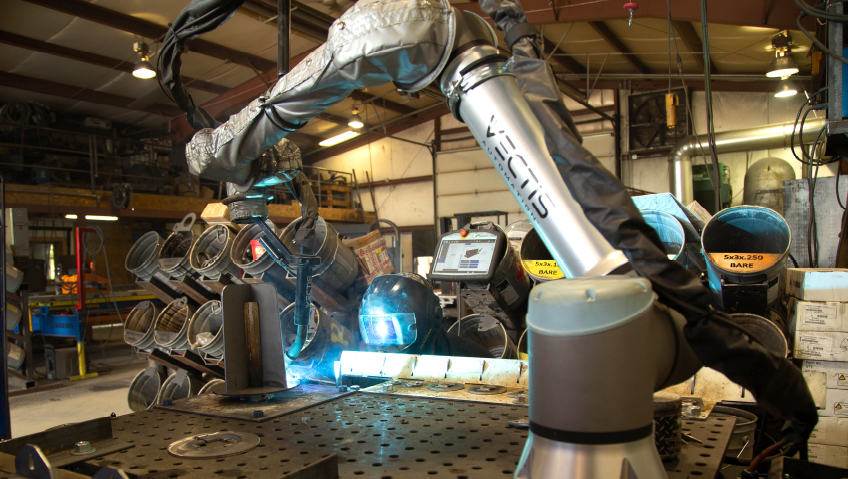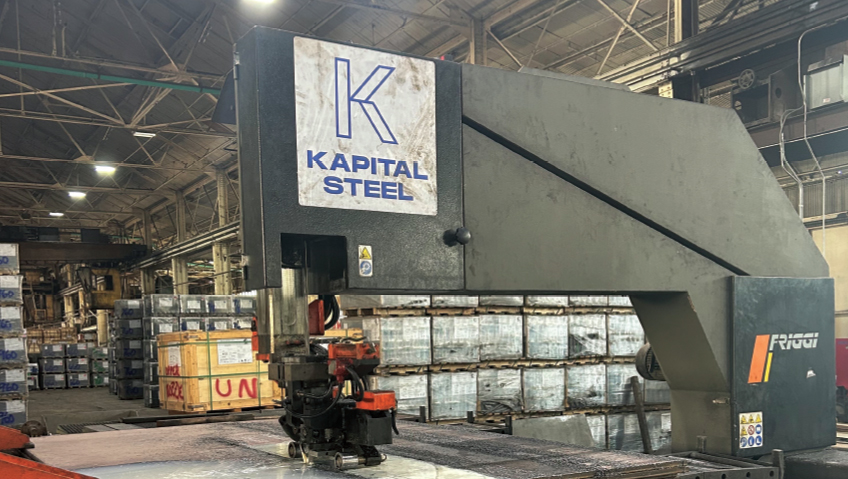Vectis Automation was formed in 2019 in Colorado by a group of colleagues with decades of experience in the robotic welding industry. This founding group included today’s Vice President of Business Development Josh Pawley, Chairman Doug Rhoda, and President Drew Akey. Pawley believes that the collective experience of the founders, especially when it comes to what the typical customer is looking for in the technical market, gave the company the strong start it needed.
Vectis began much the same way companies like Apple did—bootstrapped out of a garage and from the ground up. Today, the team has grown to around 35 people, with a healthy and growing market at its back. Akey says that continued growth with the right team members is exciting, and it is a joy to watch team members develop in their skills and careers. At its core, he says, the company looks at its products as tools—something that someone can use to make their job easier. By providing flexible and affordable cobot welding and cutting tools, the team seeks to empower manufacturers of all types and sizes to automate quickly, easily, and affordably.
When it comes to the field of industrial robotics, Vectis breaks it down into two main categories: traditional robots, which are fast and well-established but require caged safeguarding; and collaborative robots, or cobots, which are easier to program and whose built-in safety enables them to work in tandem with human effort. The fabrication space is full of both small-to-medium businesses and larger enterprises that face challenges in getting over the hurdles of integrating traditional automation solutions with long-term success, Pawley notes. “We wanted to make automation more accessible, approachable, and flexible,” he adds.
The company wants to make automation less intimidating for its clients from both the technical and commercial sides. In previous eras of the industry, traditional robots had a very steep learning curve and were a “big bet” often reserved for mass-production industries like automotive, whereas now, Vectis seeks to meet the customers where they are in their technology accessibility journey, with the tried-and-true method of keeping it simple.
Pawley explains that Vectis has multiple ways for its clients to acquire a Vectis tool, ranging in levels of cost and commitment. Some customers will want to purchase the system outright, wherein Vectis reduces risk by offering a 30-day money-back guarantee, something that is practically unheard of in capital equipment. Some customers opt for Vectis’ rent-to-own program that offers a “try before you commit” route.
Pawley feels that success in automation is nuanced and application-dependent, so one of the company’s core functions for customers is making sure its cobots can accomplish a customer’s parts effectively. “It’s about ensuring there’s a path to success for the customer. Welding applications are incredibly broad and nuanced, and our team of Application Engineers are uniquely positioned to help customers understand what automation is great at welding, what automation is poor at welding, how to ‘crawl, walk, run,’ and how to set up for long-term success.”
One of the core values of Vectis is the practice of continuous innovation deriving from customer feedback. The mechanical and software engineering teams have been continuously developing new projects and features for that reason, while also allowing customers to open up more application possibilities with those developments and innovations. Drew Akey and his technical engineering and product development teams go by the motto of: “I don’t want to see it just work; I want to see it not break,” especially where flashy solutions on social media can overshadow what actually works.
In the last three years, Vectis has experienced sustained growth from existing customers which, according to Pawley, is thanks to clients ‘crawling’ with their new technologies before they walk or run. Once customers begin to use automation as a tool in their operations, the fun is in seeing them grow into incorporating additional systems and evolving considerably beyond whence they started.
Akey says that, as founders and executives, he and Pawley always make time to talk to customers and find out what they think, and this makes Vectis different from others in the space. The most common customer feedback highlights Vectis’s ability to react quickly and smartly. Customers are thankful to the company for helping to keep things simple and for being their trusted advisor.
Pawley says that fabricators today have the same underlying challenges as they have for the last decade, including labor shortages, lead time needs, quality concerns, and overall “having to do more with less.” These are exacerbated with the recent national push toward re-shoring and near-shoring work to the United States, which is keeping businesses rather busy.
The market has also become quite crowded with a lot of outfits jumping into the cobot market because, to them, it looks easy. Pawley says that what looks simple may not be, and it is the job of Vectis to help its clients know who to trust. This crowded market can make prospective clients nervous to jump into solutions, but Vectis does its best to maintain its status as a trusted advisor to clients.
Another industry-wide challenge that impacts the business is the diminishing number of skilled performers in the industry, so education and getting young people into the skilled trades is an initiative the company supports both tangibly and intangibly. Akey says that something of a manufacturing renaissance is taking place at present; however, a great deal of effort is needed for the United States to absorb some of the re-shoring efforts that have taken place while Vectis and companies like it look to expand the workforce by using technology to a) make the workforce more productive and b) have that same technology attract new talent.
A lot of noise has been made across the corporate world about the American tariffs, which has created more consumer hesitation. Yet Akey feels that the best time to invest in the robotics and welding industry is now. The company is confident that 2025 will finish on a strong note, and Vectis will stay true to itself by not over-complicating things and meeting customers where they are while remaining hungry in its own journey.
Fall of 2025 will see the opening of the trade show season for Vectis. After a strong year of research and development efforts, the company does not plan to rest on its laurels and will keep evolving and helping its customers while growing and matching the market. An ongoing goal involves transitioning the company to employee-owned, which Pawley says will further strengthen Vectis as a fantastic place to work, play, and build purposeful things for decades to come.
The company lives by the golden rule: treat people the way you want to be treated. From top to bottom, everyone operates with competence, honesty, and integrity, and puts customer success before everything else. “Business growth comes from doing the right thing,” says Pawley. And when it comes to providing cobot welding and plasma cutting solutions, Vectis makes doing the right thing the easy thing.




